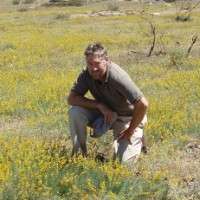Legume has potential to turn sandy soils into productive land

After a decade of research, scientists from Murdoch University are excited by a perennial legume that has the potential to turn poor soils into profitable areas suitable for farming.
Professor John Howieson from the Centre of Rhizobium Studies at Murdoch University said scientists had been searching for a something to treat deep sandy soils for 20 years and that Lebeckia, a shrub legume, has had the most exciting results to date.
Professor Howieson is working closely with the South West Catchments Council (SWCC) to find a perennial legume that might be adapted to poor soils in Western Australia and to changing climate conditions.
"There are a lot of soils within the SWCC council area that have limited options for use and are not able to be used for farming."
Four years ago Murdoch researchers established three, one hectare trial plantings of Lebeckia in Tincurrin and Harrismith in the wheatbelt region of WA and the results have been promising.
"Our research has shown that Lebeckia improves carbon content, phosphorus, nitrogen and potassium nutrition and soil fertility to the point where it can be much more profitable for cropping or grazing enterprises," Professor Howieson said.
"Our discovery is significant. We believe it has the potential to turn one million hectares of land in Western Australia and also New South Wales into usable farming land."
Lebeckia is a herbaceous plant which is woody below the soil and research has shown it has a number of benefits.
"Lebeckia will grow and persist over summer and won't drop its leaves," Professor Howieson said.
"It provides areas of grazing and shelter for sheep and unlike the tree Tagastaste you don't have to cut and carry it, you can graze it and use it through the autumn/winter feed gap.
"It produces a high quality forage as well as nitrogen."
SWCC has provided funding over the next four years for Murdoch researchers to measure the impact of establishing Lebeckia on the soil health of non-wetting, deep sandy soils. The project is designed to assess the soil fertility benefits of Lebeckia, to improve methods of establishment and to harvest seed to enable larger sowings.
Another 10 hectares will be planted in 2014 and another 10 in 2015. Researchers will then compare the health of the soil in unplanted areas, new sowings and mature strands. They will measure soil carbon and nitrogen, total organic matter and soil microflora (bugs, bacteria and fungi) via carbon dioxide release, non-wetting surface properties and worm and insect activity.
The research also hopes to reveal the success of growth according to different sowing practices, the number of healthy lambs born to sheep grazing in Lebeckia which has been planted for between two to three years and adoption by farmers of the legume.
Provided by Murdoch University





















